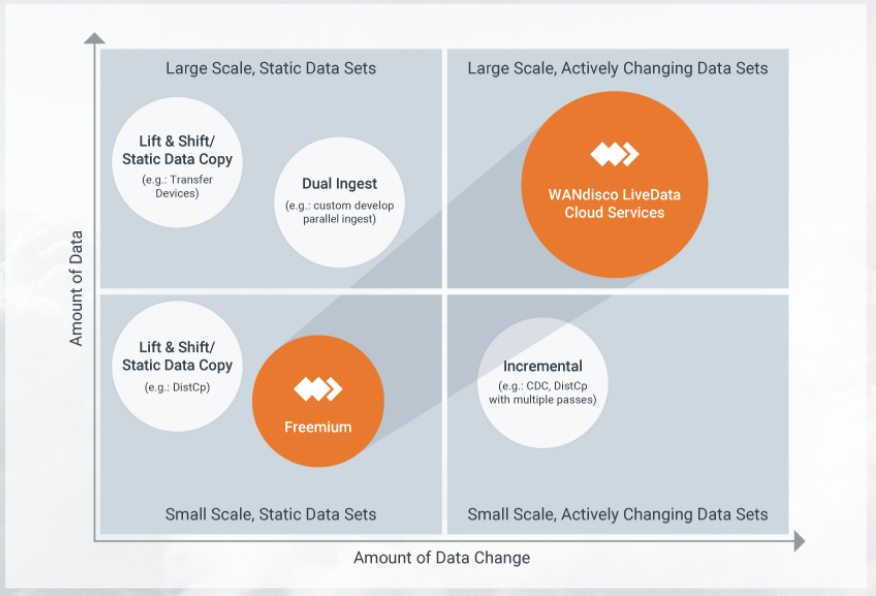3 Strategies to Navigate the Cloudera Acquisition
By Steve Kilgore
Jun 20, 2021
The private equity acquisition of Cloudera highlights the need for flexibility in cloud migration and data modernization strategies.
On June 1, Cloudera announced it was being acquired by two private equity firms and they have until July 1 to find another buyer.
After the July deadline, the PE firms as the new owners can take the company in the direction they choose.
These two scenarios are creating significant uncertainty and potential business risk for Cloudera customers. But this “triggering” event can also provide an opportunity to leapfrog into a new, more flexible approach to data migration and modernization strategies in the cloud, regardless of your decisions in the next week, quarter, or year.
The uncertainty meter is at an all-time high
The uncertainty around the Cloudera acquisition and the future cloud strategy of Cloudera customers is at its peak right now. Despite the 30-day clause, one would expect that Cloudera will become a private company with new PE owners in July. Cloudera customers have to make a decision -- the status quo is no longer an option. Cloudera customers will have to move off of CDH or HDP and onto either CDP or another cloud provider. While the key question is ‘Where do we move?’, there’s another thorny issue of ‘How do we move there once we decide?’ And of course, what if something unexpected happens and we need to change our minds?
If you move to CDP then you are recommitting to the Cloudera business ecosystem and the uncertainty that comes with the new ownership. That might not be a bad thing if you are all in on Hadoop and your roadmap is based on it. If, on the other hand, you plan to move to one of the native cloud platforms, then you’re likely aggressively exploring which platform(s) to move to and how to run your applications across one or more of them.
Here are three strategies to unlock value amidst the uncertainty, whatever direction you choose:
3 strategies to benefit from the Cloudera acquisition
1. Capitalize on the uncertainty
Assess your confidence in both current and future partners and platforms. If Cloudera is where you want to go, the acquisition may present an opportunity to reassess terms and restructure your approach to better fit your roadmap. If you feel that may introduce too much risk into the equation, it may be time to explore flexible options for a staged cloud strategy, given all the moving parts. This could be the triggering event that accelerates your cloud migration strategy. Adopting a data-first approach provides flexibility and options, should you choose to change direction later. Despite the unknowns, there can be opportunity in uncertainty.
2. Free your data once and for all
CDP means many things in the pantheon of technology acronyms -- Cloudera Data Platform, Customer Data Platform, etc. It’s time to introduce another: Choose your Data Platform. The ability to go to multiple platforms will take on increasing importance over time, from both a disaster recovery perspective and in terms of business agility as well. If you're going to Databricks, for example, that means you have options to choose which cloud platform you're going to run Databricks on. If you have some business units that want to utilize Databricks and others that want to use Snowflake, you may want to adopt a data strategy that supports and facilitates that flexibility. Automated data solutions that keep rapidly changing and up-to-date, live data enable flexibility without the risk of business downtime every time you want (or need) to adjust some aspect of your cloud strategy.
3. Reexamine your plans for transition to the cloud
The Cloudera acquisition added change on multiple fronts. There's the cloud platform question but also the fact that datasets often change -- potentially at both high volumes and velocities. Even once you decide which platform to move to, migrating changing data is complex and fraught with risk -- and it’s a much more difficult task without a solution designed with those risks and challenges in mind. You don’t have to rely on a Big Bang, One-and-Done migration strategy. It’s possible to stage the migration across different platforms and take it in incremental batches before scaling. This staging allows for a solution that is both less risky and more cost effective.
How WANdisco helps mitigate risk of uncertainty
WANdisco LiveData Migrator is specifically designed to handle changing data and is built to make it easy to migrate to whatever platform you may choose, including CDP, Azure, AWS, Google Cloud Platform, Databricks, Snowflake, etc. It’s easy to move to multiple platforms and adopt a test-and-learn approach that doesn’t bet the farm -- or your career -- on a single decision or platform. In the face of uncertainty, the best approach is often one that maximizes your ability to react to new developments in a rapid and agile manner while continuing to move your business forward.

 Steve Kilgore
Steve Kilgore
Senior Vice President, Field Operations, WANdisco
Steve has over 30 years of industry experience including stints at Sun Microsystems and Oracle, as well as running his own successful consulting company for over 16 years. He has served as a trusted advisor to companies such as Fannie Mae, Freddie Mac, Charles Schwab, Nike, and Delta Airlines. Steve holds Bachelors and Masters degrees in Computer Science from the University of Tennessee, Knoxville.

